ND Filter Tabelle: Die richtige Belichtungszeit mit ND Filter
Um das Verständnis generell erst einmal herzustellen, ist es wichtig zu wissen um wie viele Blenden ein ND Filter verdunkelt. Die unterschiedlichen Stärken der Filter geben an, um wie viele Blenden dieser das Licht vermindert. So verdunkelt ein ND8 Filter beispielsweise um 3 Blendenstufen, ein ND1000 Filter um 10. Mit diesem Wissen sollten Sie als Fotograf die nachfolgende Berechnung einfacher verstehen können.
Berechnung der Verschlusszeiten mit ND Filter
Die Berechnung der Verschlusszeiten mit Graufilter ist ein einfacher Vorgang, der nur wenige Schritte erfordert und für jeden Fotografen problemlos möglich sein sollte. Ein Taschenrechner ist bei dem Vorgehen von Vorteil, diesen hat man aber in Form seines Handys eigentlich immer bei sich. Die notwendigen Schritte sehen Sie hier:
- Zuerst installiert man alle Filter mit Ausnahme des Graufilters in seinem Filterhalter oder schraubt diese direkt auf das Objektiv. Dann macht man eine korrekt belichtete Probeaufnahme, und merkt sich die Länge der Belichtungszeit. In unserem Beispiel 1/125 Sekunden.
- Jetzt montieren wir den Graufilter, beispielsweise den Kase ND1000 100x150 mm, und merken, dass die Bezeichnung ND1000 lautet. Die 1000 gibt dabei an, mit welchem Wert die Verschlusszeit multipliziert werden muss wenn der Filter montiert wurde. Denn mit montiertem Filter, trifft 1000-mal weniger Licht auf den Sensor. Deswegen muss die Belichtungszeit um das 1000-fache verlängert werden.
- Wenn eine Verschlusszeit vom Bruchteil einer Sekunde von der Kamera ausgegeben wurde (hier 1/125s), sollte der Wert in Sekunden umgerechnet werden. So entspricht 1/125s = 0,008 Sekunden, also 1 geteilt durch 125.
- Dieser Wert wird mit 1000 multipliziert, das bedeutet 0,008s x 1000 = 8 Sekunden. Also ist dies die benötigte Belichtungszeit, um eine Aufnahme mit derselben Belichtung nach Anbringung des ND1000 Graufilters zu erzielen. Im Standardmodus der Kamera werden daraufhin 15 Sekunden eingestellt, da das der nächste Wert ist, der eingestellt werden kann. Auch möglich wäre es, die Belichtungszeit mit einer Timer Fernbedienung die exakte Belichtung von 16 Sekunden einzustellen.
- Wenn wir nun beispielsweise einen ND64 100x150 mm benutzen, würde die Berechnung 0,008s x 64 = 0,512 Sekunden lauten. Das ergibt eine Verschlusszeit von ungefähr 1/2 Sekunde.
Diese Berechnungen können bei der Landschaftsfotografie in der Natur dennoch teilweise unpraktisch sein. Unsere einfache Tabelle kann Ihnen dabei helfen die Berechnungen zu umgehen.
ND-Filter Tabelle
Unten finden Sie nun die einfachere Methode mit Hilfe einer Umrechnungstabelle. Das Ablesen ist dabei sehr simpel: Zuerst suchen Sie sich den ND-Filter heraus, den Sie verwenden wollen. In der linken Spalte finden Sie dann die Zeit, die Sie bei der Probeaufnahme an der Kamera eingestellt haben. In den rechten Spalten finden Sie die passende Belichtungszeit, nachdem Sie den ND-Filter vor dem Objektiv installiert haben. Die Tabelle lässt sich auch andersherum verwenden, wenn Sie also eine bestimmte Belichtungszeit erreichen möchten und wissen wollen, welchen ND-Filter Sie dafür verwenden sollten.
ND Filter Exposure Table
Exposure times chart with different filter strengths
| Exposure time without ND filter | 3 Stops 0.9 ND8 | 4 Stops 1.2 ND16 | 5 Stops 1.5 ND32 | 6 Stops 1.8 ND64 | 7 Stops 2.1 ND128 | 8 Stops 2.4 ND256 | 9 Stops 2.7 ND512 | 10 Stops 3.0 ND1000 | 11 Stops 3.3 ND2000 | 15 Stops 4.5 ND32000 |
|---|---|---|---|---|---|---|---|---|---|---|
| 1/8000s | 1/1000s | 1/500s | 1/250s | 1/125s | 1/60s | 1/30s | 1/15s | 1/8s | 1/4s | 4s |
| 1/4000s | 1/500s | 1/250s | 1/125s | 1/60s | 1/30s | 1/15s | 1/8s | 1/4s | 1/2s | 8s |
| 1/2000s | 1/250s | 1/125s | 1/60s | 1/30s | 1/15s | 1/8s | 1/4s | 1/2s | 1s | 16s |
| 1/1000s | 1/125s | 1/60s | 1/30s | 1/15s | 1/8s | 1/4s | 1/2s | 1s | 2s | 32s |
| 1/500s | 1/60s | 1/30s | 1/15s | 1/8s | 1/4s | 1/2s | 1s | 2s | 4s | 1m 4s |
| 1/250s | 1/30s | 1/15s | 1/8s | 1/4s | 1/2s | 1s | 2s | 4s | 8s | 2m 8s |
| 1/125s | 1/15s | 1/8s | 1/4s | 1/2s | 1s | 2s | 4s | 8s | 16s | 4m 16s |
| 1/60s | 1/8s | 1/4s | 1/2s | 1s | 2s | 4s | 8s | 16s | 32s | 8m 52s |
| 1/30s | 1/4s | 1/2s | 1s | 2s | 4s | 8s | 16s | 32s | 1m 6s | 17m 6s |
| 1/15s | 1/2s | 1s | 2s | 4s | 8s | 16s | 32s | 1m 6s | 2m 13s | 33m 20s |
| 1/8s | 1s | 2s | 4s | 8s | 16s | 32s | 1m 4s | 2m 5s | 4m 10s | 1h 6m 40s |
| 1/4s | 2s | 4s | 8s | 16s | 32s | 1m 4s | 2m 8s | 4m 10s | 8m 20s | 2h 13m 20s |
| 1/2s | 4s | 8s | 16s | 32s | 1m 4s | 2m 8s | 4m 16s | 8m 20s | 16m 40s | 4h 26m 40s |
| 1s | 8s | 16s | 32s | 1m 4s | 2m 8s | 4m 16s | 8m 32s | 16m 40s | 33m 20s | 8h 46m 40s |
| 2s | 16s | 32s | 1m 4s | 2m 8s | 4m 16s | 8m 32s | 17m 4s | 33m 20s | 1h 6m 40s | 17h 23m 20s |
| 4s | 32s | 1m 4s | 2m 8s | 4m 16s | 8m 32s | 17m 4s | 34m 8s | 1h 6m 40s | 2h 13m 20s | 1d 12h 24m 32s |
| 8s | 1m 4s | 2m 8s | 4m 16s | 8m 32s | 17m 4s | 34m 8s | 1h 4m 18s | 2h 13m 20s | 4h 26m 40s | 3d 0h 49m 4s |
| 15s | 2m | 4m | 8m | 16m | 32m | 1h 4m 18s | 2h 13m | 4h 26m | 8h 53m | 5d 16h 32m |
| 30s | 4m | 8m | 16m | 32m | 1h 4m | 2h 8m 36s | 4h 26m | 8h 53m | 17h 6m | 11d 9h 4m |
Welche Effekte lassen sich mit einem Graufilter erzielen?
Der Graufilter kommt nicht nur zum Einsatz, um bei strahlendem Sonnenschein zu fotografieren. Mit einem Graufilter lassen sich die unterschiedlichsten Effekte erzeugen, wie beispielsweise das Verschwinden lassen von Menschen auf belebten Plätzen. Als Faustregel kann man sich merken, dass je dunkler der Graufilter ist, desto stärker ist auch der erzielte Effekt. Die folgenden Effekte, sind die Gängigsten und von den meisten Fotografen am häufigsten gewünscht:
- Bei Architekturaufnahmen kann man Personen verschwinden lassen
- Wischeffekte bei Wasser oder bei Wolken
- Durchgezogene Lichtspuren können bei fahrenden Autos erzeugt werden
Welche Hilfsmittel benötigt man bei Langzeitbelichtungen mit Graufilter?
Besonders beim Fotografieren von Landschaften und Gebäuden ist ein nicht verwackeltes Bild essentiell. Damit das ausgewählte Motiv auch auf dem Foto perfekt dargestellt wird, ist das folgende Equipment fast Pflicht.
- Stabiles und nicht zu schweres Stativ
- Fernauslöser
- Korrekturtabelle oder ein Taschenrechner für das Einstellen der Belichtungszeiten
Selbst mit einem sehr guten und stabilen Stativ kann es dazu kommen, dass Unschärfe im Bild auftreten. Dies liegt dann aber meistens nicht an einem unzureichend festen Stand, sondern an der Spiegelvorauslösung der Kamera. Um die perfekte Aufnahme zu erzeugen, ist es deswegen wichtig selbst die kleinsten Erschütterungen zu vermeiden. Um das zu erreichen, kann man einfach bei Spiegelreflexkameras die Spiegelvorauslösung einschalten.
Durch die Aktivierung der Spiegelvoreinstellung wird der Spiegel der Kamera bereits vor der eigentlichen Aufnahme hochgeklappt. In dieser Position verharrt der Spiegel dann. Drückt man dann den Auslöser der Kamera, ist die Erschütterung durch das Hochklappen des Spiegels schon geschehen. Dann wird lediglich der "Vorhang" der Kamera geöffnet, um die Belichtung durchzuführen, dadurch kann das Spiegelklappen keine negative Wirkung mehr auf das Bild haben.
Top seller
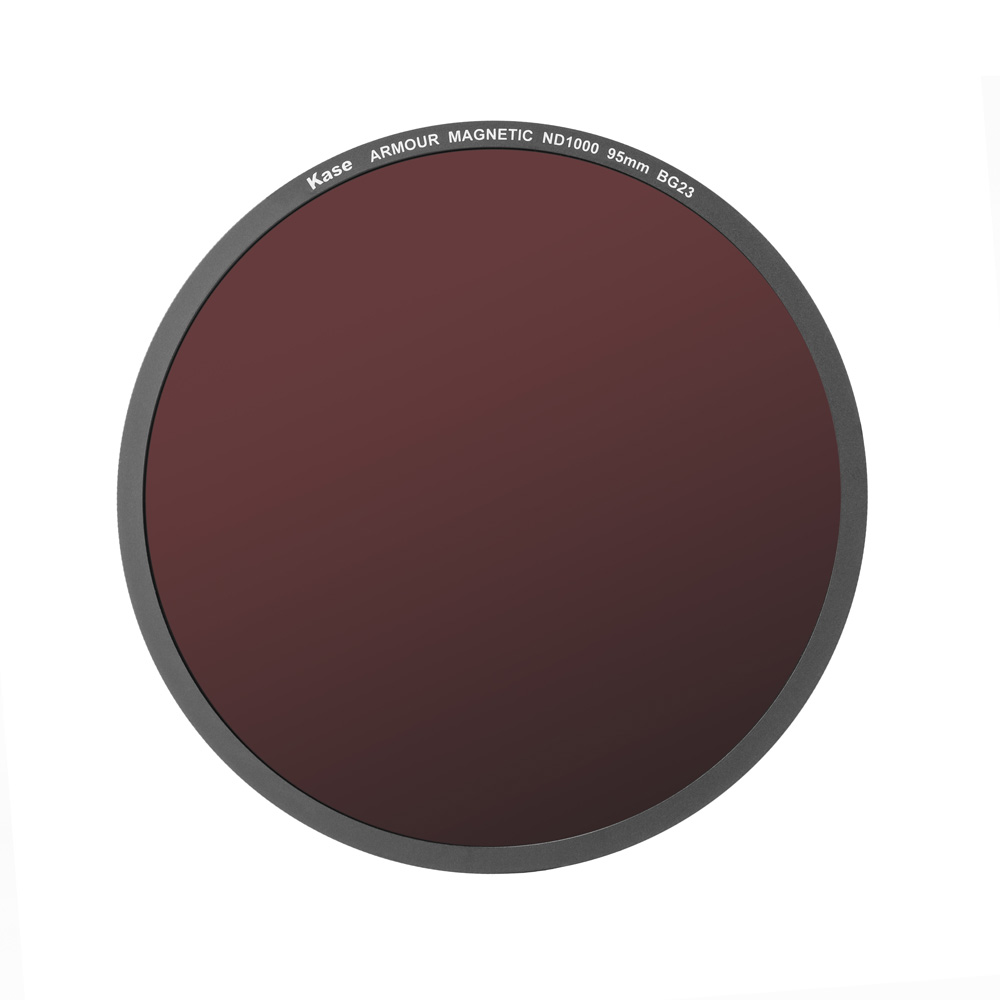
🌑 Kase ARMOUR ND1000 filter - Magnetic 10-stop grey filter for perfect long exposures With the Kase ARMOUR ND1000 filter, you get a high-quality, colour-neutral neutral density filter with 10 f-stops - ideal for dramatic long exposures in daylight. 🧲 Thanks to the magnetic attachment, the filter is ready for use in no time at all and sits securely in the ARMOUR filter holder. 🎯 Ideal for creative exposure effects 🌊 ND1000 (10 stops): Drastically extends your exposure time - for smooth water surfaces, moving clouds & light trails 🖼 Maximum depth of field: Even the finest details remain razor-sharp 🎨 Colour-neutral: No colour casts, no compromises in image quality 🧲 Magnetic, practical & compatible 🧲 95 mm magnetic filter: Fits exactly into one of the two recesses in the ARMOUR filter holder 🔄 Can be combined: Use it together with the ARMOUR polarising filter or other ND filters ⚙️ Quick change: No screwing - just put it on & get started 💪 Best materials for the best images 🔬 C oated optical glass: scratch-resistant and high-quality workmanship 💧 Robust & durable: For use in wind, weather and changing light conditions 📦 Scope of delivery ✅ 1× Kase ARMOUR ND1000 filter (95 mm, 10 stops) 📦 1× storage case 💡 Your advantage: The ARMOUR ND1000 filter offers you maximum control over your exposure and can be inserted magnetically at lightning speed & safely. The perfect solution for creative long exposures - anytime & anywhere.
In Stock
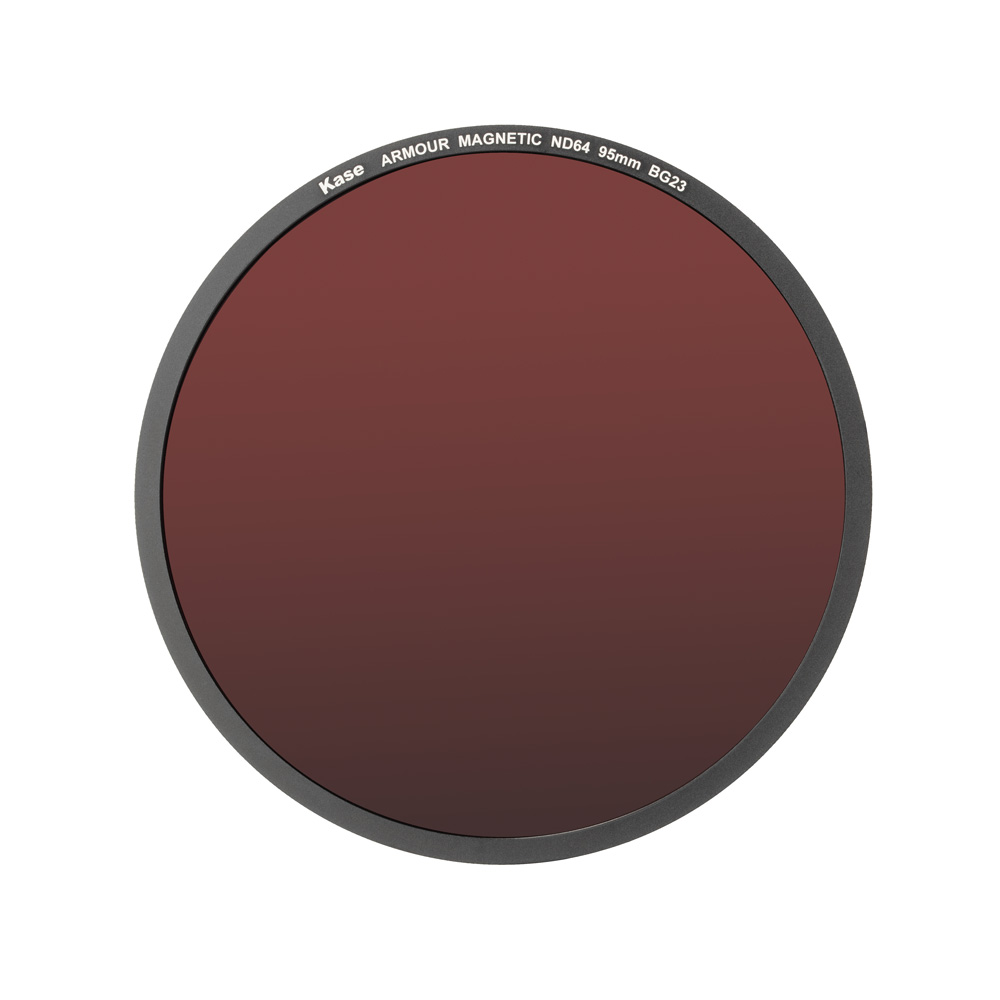
🧲 ARMOUR Magnetic ND64 Filter - 6 Stops The ARMOUR ND64 filter is the ideal choice for photographers who want to work with longer exposure times in daylight. With a reduction of light by 6 f-stops, it opens up creative scope - from flowing water to crowded squares and softly drawn cloud movements. The filter is magnetically attached to the ARMOUR filter holder and can be easily combined with other ND filters or an ARMOUR polarising filter. Thanks to the coated optical glass, it impresses with the highest image quality, durability and easy cleaning. ✨ Features 🌗 6 f-stops of light reduction - ideal for long exposures in daylight 🧲 Magnetic attachment in the ARMOUR 100mm filter holder 📏 Diameter: 95 mm - compatible with many lenses via step-up rings 🔄 Can be combined with ARMOUR ND1000 or ARMOUR CPL polarising filter 💎 High-quality, coated optical glass for clear and colour-neutral results 🛡️ Robust design - ideal for outdoor use 📸Examples of applications 🌊 Long exposures of water: transform rivers, lakes or the sea into velvety smooth surfaces. ☁️ Dramatically capture moving clouds: Perfect for atmospheric sky shots with depth and dynamism. 🏙️ Make people and vehicles disappear: Ideal for busy squares or streets with long exposures. 🎨 Creative experiments: light trails, abstract shapes or minimal landscapes with exposure control. 📽️ Filming in daylight: Controlled exposure without stopping down - perfect for cinematic video recordings. 📦 Scope of delivery 1x ARMOUR ND64 filter (6 stops, 95 mm) 1x storage case
In Stock

Average rating of 5 out of 5 stars
🧲 ARMOUR Magnetic ND8 filter - 3 stops The ARMOUR ND8 filter reduces the incident light by 3 f-stops and is therefore ideal for finely controlled long exposures, video recordings in daylight or the targeted opening of the aperture in bright surroundings. With a diameter of 95 mm, the filter fits perfectly into the ARMOUR 100 mm filter holder and is magnetically attached to it. For even more creative flexibility, the ND8 filter can be easily combined with other ND filters or an ARMOUR polarising filter. ✨ Features 🌗 3 f-stops of light reduction - ideal for controlled long exposures 🧲 Magnetic attachment in the ARMOUR filter holder system 📏 Diameter: 95 mm - compatible with lenses via suitable adapter rings 🔄 Can be combined with ARMOUR ND64, ND1000 or CPL polarising filter 💎 Coated optical glass - for sharp and colour-neutral results 🛡️ Robust, weatherproof construction - ideal for outdoor use 📸 Examples of applications 🌊 Light long exposures: e.g. flowing water surfaces with a soft effect 📽️ Video shoot in daylight: constant shutter speeds without overexposure 🌞 Clipping with an open aperture: Reducing the amount of light for portraits in sunlight 🏞️ Emphasising cloud structures: subtle movement effects in the sky 📷 Filter stacking: can be combined with ND64 or ND1000 for even longer exposure times 📦 Scope of delivery 1x ARMOUR ND8 filter (3 stops, 95 mm) 1x storage case
In Stock

🪟 Kase K100 Wolverine ND1000 100x150mm - 10 stops The Kase ND1000 (ND 3.0) is a professional 100x150mm grey filter that reduces the amount of light by 10 stops - ideal for creative long exposures in daylight. ✨ Product highlights 🌫️ 10 stops light reduction: Exposure times are extended by a factor of 1000 for dramatic effects 📷 O utstanding colour neutrality: No colour cast - perfect colour reproduction without post-processing 🪟 High-quality optical glass: Extremely robust & shock-resistant 💧 Nano coating: Oil and water-repellent for easy cleaning 🧲 Practical case with magnetic closure: Secure & quick access 📸 Typical applications Long exposures in bright daylight Soft focus of water, clouds & moving objects Architectural photography with "empty" surfaces Creative motion blur effects 📐 Compatibility Suitable for all 100mm filter holders (e.g. Kase K9, KW Revolution) 📦 Scope of delivery 1x ND1000 filter (ND 3.0, 10 stops) - 100x150mm 1x storage bag with magnetic fastener
In Stock
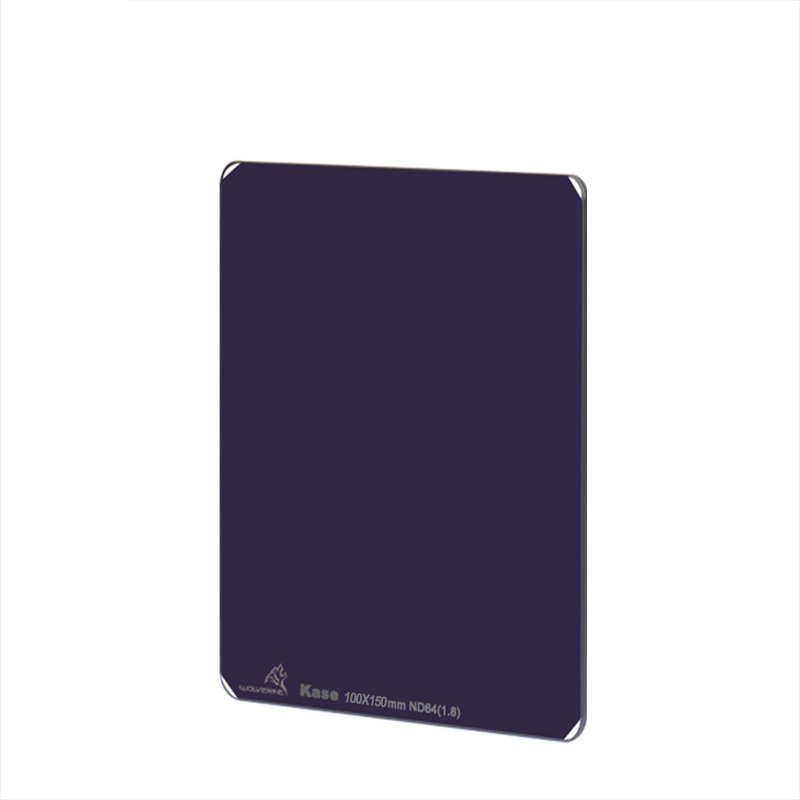
🌑 K100 Wolverine ND64 6 Stops ND 1.8 100x150mm The K100 Wolverine ND64 6 Stops filter is a neutral density filter that reduces the incident light by 6 f-stops. Ideal for creative long exposures, dramatic landscape shots and precise exposure control - even in intense daylight. ✨ Features & benefits 🌑 ND64 neutral density filter: Reduces light by 6 stops - perfect for long exposures 📏 Dimensions: 100x150mm, 2mm glass thickness - compatible with standard 100mm filter systems 🔬 Made from high-quality Schott B270 glass for maximum optical clarity 💧 Nano coating: water, oil and dirt-repellent for easy cleaning 🖤 Black anodised frame edges to minimise reflections 📷 Areas of application 🌊 Landscape photography: Gentle water surfaces and dramatic cloud movements 👥 Portraits in sunlight: Use open aperture for soft bokeh despite bright light 🏙️ Architecture & urban: soften the movement of people or clouds ☀️ Long exposures during the day: creative effects in intense sunlight 📦 Scope of delivery 1x K100 Wolverine ND64 6 Stops ND 1.8 100x150mm 1x bag with magnetic fastener for safe storage
Preorder possible
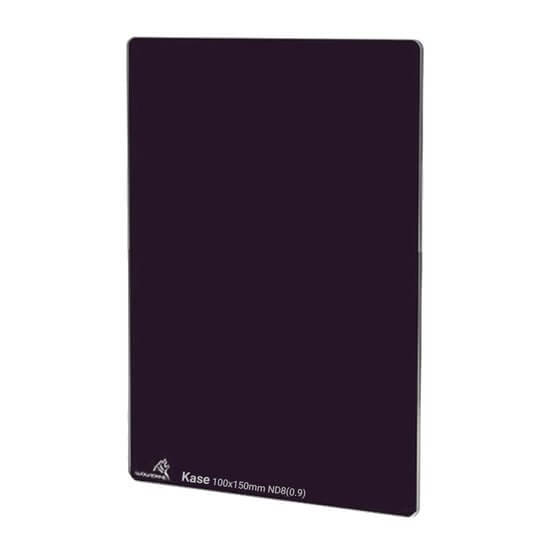
🌑 K100 Wolverine ND8 ND 0.9 3 Stops 100x150mm The K100 Wolverine ND8 filter reduces the amount of light by 3 f-stops (ND 0.9) and enables longer exposure times even in bright daylight. Ideal for long exposures in landscape and architectural photography. ✨ Features & advantages 🌑 ND8 neutral density filter: 3 stops of light reduction for creative exposure control 📐 D imensions: 100x150mm | glass thickness 2mm - compatible with standard 100mm filter holders 🔬 Optical Schott B270 glass with excellent colour neutrality 💧 O il, water & dirt-repellent nano-coating for easy cleaning 🪶 Impact-resistant, high-precision glass for maximum reliability in outdoor use 📷 Areas of application 🌊 Landscape photography: create silky smooth images of flowing water or waves ☁️ Long exposures: Visualising the movement of clouds or people 🏙️ Architectural photography: Dynamic effects through motion blur in urban scenes 📸 Portraits in sunlight: Larger aperture possible for beautiful bokeh 📦 Scope of delivery 1x K100 Wolverine ND8 ND 0.9 filter (3 stops | 100x150mm) 1x protective bag for storage
In Stock
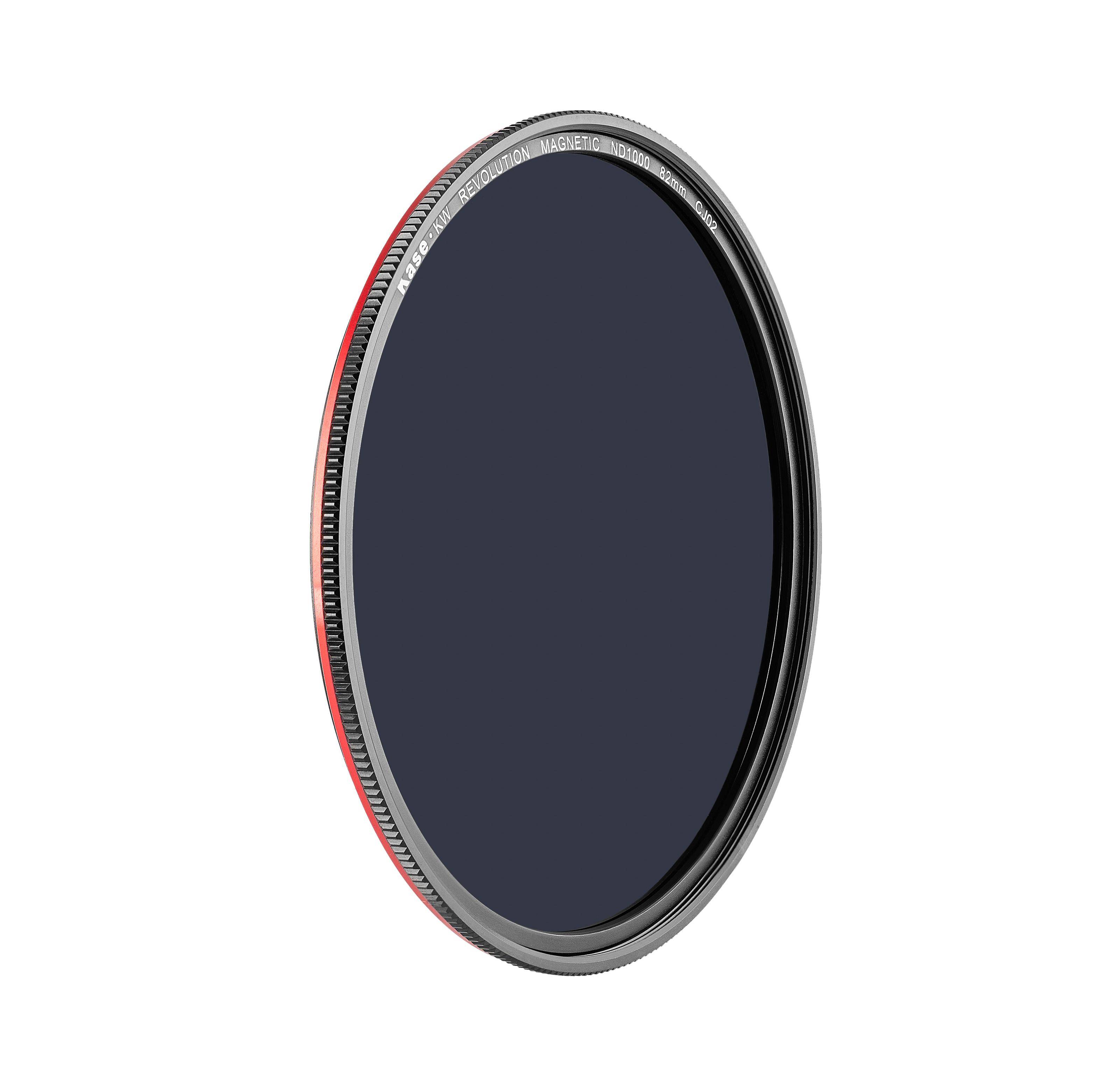
🧲 KW Revolution Magnetic ND1000 round filter (10 stops) The KW Revolution Magnetic ND1000 filter reduces the incident light by 10 f-stops, opening up a wide range of creative possibilities in long exposure photography. With its magnetic attachment, it can be mounted particularly quickly and securely on the lens - ideal for landscape photography, architectural shots or dynamic long exposures. ✨ Creative control with 10 stops 📸 Extends the exposure time by 10 f-stops - perfect for long exposures in daylight 🌊 Creates silky-smooth water surfaces on rivers, lakes and waterfalls ☁️ Makes cloud movements appear dynamic and artistic 🏙️ Ideal for architectural & urban photography - people's movements become blurred, buildings remain razor-sharp 🧲 Magnetic filter system 🧲 Quick mounting without screws - secure hold thanks to magnetic force 🔄 Compatible with other magnetic ND and CPL filters from the same series 🎨 Coloured frame (red) for quick filter recognition 🔬 High-quality materials 🪶 Hardened optical glass for maximum robustness 💧 Oil and water-repellent multi-layer coating for easy cleaning ⚙️ Aluminium frame with magnetic strips - stable and durable 🛡️ Coated against IR, scratches & fogging 📦 Scope of delivery 1x KW Revolution Magnetic ND1000 round filter (10 stops, red frame) 1x Magnetic adapter ring for screwing onto the lens 1x storage box
Preorder possible
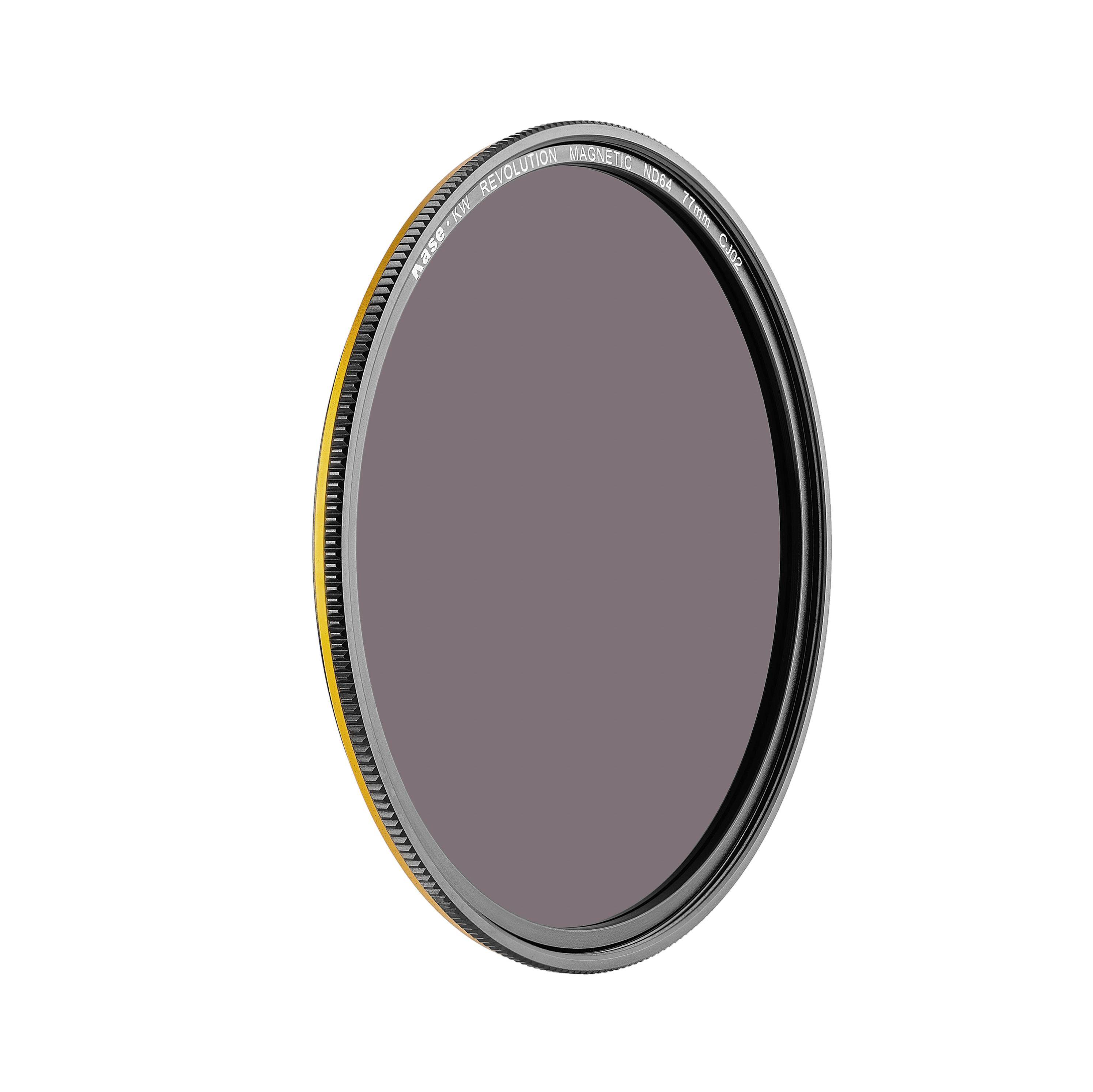
🌒 KW Revolution Magnetic ND64 round filter - 6 stops for perfect long exposures The KW Revolution ND64 round filter reduces the incident light precisely by 6 f-stops - ideal for landscape photography, long exposures and creative photography in daylight. Thanks to the innovative magnetic attachment system, the filter can be attached or removed quickly and without tools. The supplied adapter ring remains permanently attached to the lens and is also compatible with other magnetic KW filters. ✨ Advantages at a glance: 🧲 Magnetic attachment: Filter change in seconds - no screws required 🌫️ 6 Stops ND64: Ideal for long exposures & daylight photography 🎯 Colour-neutral & sharp: No colour cast, highest image quality 🧼 Easy Clean: oil & water-repellent nano-coating 🟡 Coloured frame: Yellow marking for quick identification 🧪 Technical properties: 📸 Material frame: Aluminium with magnetic strip 🔍 Glass: Hardened optical glass, impact-resistant & high-quality tempered 🛡️ Coatings: Anti-IR, anti-scratch, anti-fog, easy-clean 📦 Scope of delivery: 🌒 1x KW Revolution Magnetic ND64 round filter (yellow frame) 🧲 1x magnetic adapter ring (for screwing onto your lens) 🎁 1x storage box 🌍 Ideal for photographers who want to combine precise exposure and creative control with maximum ease of use - made for long exposures.
Preorder possible
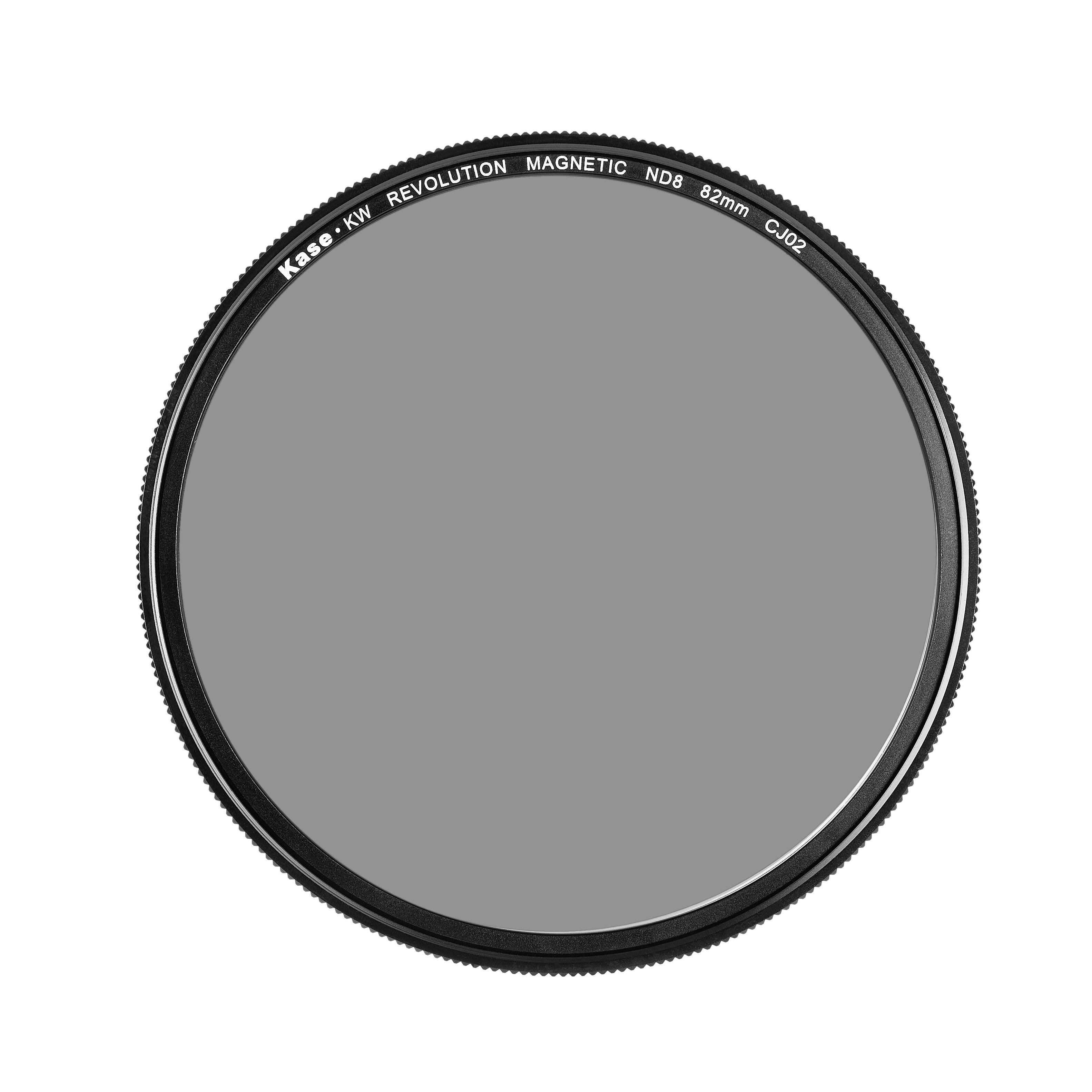
Average rating of 4 out of 5 stars
🧲 KW Revolution Magnetic ND8 round filter - 3 stops of light control for creative long exposures The KW Revolution ND8 magnetic filter reduces the incident light by 3 f-stops - perfect for long exposures in daylight to create motion blur in water, clouds or crowds. Thanks to the magnetic quick-release system, you can attach or change the filter in seconds - without any screws. The supplied adapter ring remains on the lens so that you are always ready to go. ✨ Features & benefits: 🧲 Magnetic mounting: quick & convenient - no more screws required 🌗 3 stops of light reduction (ND8): Ideal for light long exposures 🎨 Coloured frame (blue): For quick filter recognition in the setup 🔍 High-quality optical glass: Colour-neutral, shock-resistant & precisely processed 💧 Multi-coated: Oil, water and dirt-repellent 🔄 Compatible with: All KW Revolution magnetic filters (same diameter) 📦 Scope of delivery: 🔵 1x ND8 magnetic filter (3 stops, blue frame) 🧲 1x magnetic adapter ring for screwing in 🎁 1x storage box ✅ Ideal for landscape photography, water photography or creative street photography in daylight - compact, efficient and 100% compatible with the KW Revolution magnetic ecosystem.
Preorder possible

